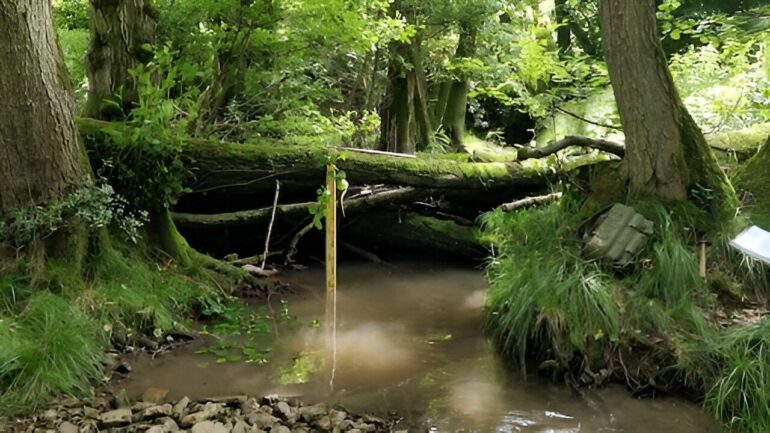River barriers made up of natural materials like trees, branches, logs and leaves can reduce flooding in at-risk communities by storing water upstream, new research has found.
The study, led by scientists from Cardiff University and the University of Worcester, assessed the impact of leaky barriers at a natural flood management site on a small Shropshire river over a period of two years.
Human-made leaky barriers, which are designed to imitate beaver dams, work in units of 50–100, deliberately raising water levels upstream to slow down river flow through storage and diversion, providing ecological benefits to the river corridor and on nearby farmland.
Until now scientists have used numerical modeling based on multiple assumptions to measure their impact, but the Cardiff and Worcester team gathered real data from 105 leaky barriers over a distance of three miles to understand how they operate when they are overtopped by flood waters.
Their study, published in the Journal of Hydrology, found the site’s leaky barriers could store enough water to fill at least four Olympic-sized swimming pools during significant weather events such as Storm Dennis.
The team recorded raised water levels up to 0.8 meters at each barrier, which they say slowed the flow of the river during these storm events taking between seven and nine days to return to normal and protecting communities from flooding downstream.
Dr. Catherine Wilson, a Reader at Cardiff University’s School of Engineering and one of the study’s authors, said, “In recent years, we’ve seen a significant increase in flood risk across the U.K. and internationally due to greater storm intensity and other climate change-related factors.
“Where flooding does occur, we often see extreme human and socio-economic cost. And so, it’s vital that we better understand how to combat these events in the most effective way possible.”
The team placed monitoring equipment on three channel-spanning leaky barriers to measure their effects on water levels upstream and downstream over time.
Further data was extracted from drone images of the site using a technique known as photogrammetry, which enabled the team to make extremely accurate measurements of the land elevation in areas of the river covered by trees and other flora.
“For the first time, our study provides quantifiable in-depth evidence of the effectiveness of nature-based solutions in tackling these flood events. We show that leaky barriers are effective in slowing down the flow of the river during periods of rainfall, storing up vast quantities of water which would otherwise rush through causing damage to communities downstream. Instead, this force is slowly released over a period of a week to 10 days,” says Wilson.
“Leaky barriers are most effective in narrow channels with steep banks and better at reducing flooding during smaller storm events than during larger ones. This tells us that they are a valuable addition to existing flood management strategies.
“Not only that, leaky barriers offer a low-cost solution of between £50 and £500 and are a sustainable flood defense which increases biodiversity in our rivers and on nearby land.”
The team are continuing to monitor the effectiveness of leaky barriers at the Shropshire site, which is one of sixty identified by the Department for Environment, Food and Rural Affairs, to evaluate natural flood management.
They say their findings can be used by government and industry to develop flood defenses for smaller, more frequent storms, and help create an approach for modeling leaky barriers for larger storms as well.
Professor Ian Maddock, Professor of River Science at the University of Worcester and one of the study’s co-authors, said, “The results of the study have helped inform our work with local authorities to identify new sites for natural flood management. It’s enabled us to target sites where the installation of leaky barriers will have the greatest impact in reducing flood risk to communities and landowners downstream.”
More information:
Valentine Muhawenimana et al, Field-based monitoring of instream leaky barrier backwater and storage during storm events, Journal of Hydrology (2023). DOI: 10.1016/j.jhydrol.2023.129744
Provided by
Cardiff University
Citation:
Beaver-like dams can enhance existing flood management strategies for at-risk communities, study finds (2023, August 8)



